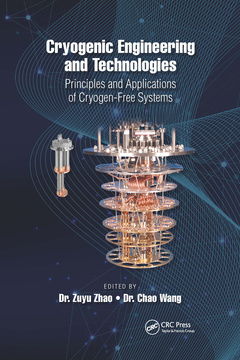Description
Cryogenic Engineering and Technologies
Principles and Applications of Cryogen-Free Systems
Language: English
Subjects for Cryogenic Engineering and Technologies:
Keywords
Temperature Dependent Raman Spectra; Heat Switch; helium-free; Distributed Heat Load; cryocoolers; Cold Head; cryogenic systems; Pulse Tube; 4k cryosystem; Liquid Helium; refrigeration technology; 3He Cryostat; adiabatic demagnetization refrigerator; Liquid 3He; dilution refrigerator; Rare Earth Materials; cryogen-free superconducting magnet; Thermal Link; cryogen free system; OFHC Copper; 4K cryocooler; Cooling Power; Heat Exchanger; Helium Gas; Salt Pill; HTS Material; 3He Gas; Superconducting Magnet; Charcoal Sorb; DR System; Dilute Phase; Rotary Valve; Helium Liquefaction; 3He Concentration
Publication date: 06-2022
Support: Print on demand
Publication date: 11-2019
· 17.8x25.4 cm · Hardback
Description
/li>Contents
/li>Biography
/li>
Cryogen-free cryogenics is leading a revolution in research and industry by its significant advantages over traditional liquid helium systems. This is the first overview for the field, covering the key technologies, conceptual design, fabrication, operation, performance, and applications of these systems. The contents cover important topics such as the operating principles of 4 K cryocoolers, enabling technologies (including vibration reduction) for cryogen-free systems, the cryogen-free superconducting magnet, and cryogen-free systems that reachmillikelvin. It highlights the wide range of applications in materials science, quantum physics, astronomy and space science, medical sciences, etc.
Key features:
? Introduces technologies and practical know-how employed for cryogen-free systems of using 4 K cryocoolers to replace liquid helium
? Addresses state-of-the-art of cryogen-free superconducting magnets, subkelvin refrigeration systems of the He-3 sorption cooler, adiabatic demagnetization refrigerator (ADR) and dilution refrigerators (DR)
? Discusses applications of cryogen-free systems in modern instruments and equipment
1. Evolution of Cryogenic Engineering. 2. Helium: Its Application, Supply, and Demand. 3. 4k Regenerative Cryocoolers. 4.Features and Characteristics of 4k Cryocoolers. 5. Reduction of Vibration and Drift. 6. Enablisng Technologies. 7. Cryogen Free Superconducting Magnets. 8. Cryogen-free 4k and 1.5k Systems. 9. Cryogen-free 3He Systems. 10. Adiabatic Demagnetization Refrigerator (ADR) Systems. 11. Cryogen-free Dilution Refrigerator.
Dr. Zuyu Zhao received his B.S. degree from Fudan University in 1982, Class 77. He came to the United States in 1983 with the World Bank Scholarship program and graduated from Northwestern University with a Ph.D. degree of physics in 1990. He then spent two and a half years working at Harvard University as a post-doc and set up a new lab pursuing Bose-Einstein condensation on spin polarized hydrogen. Dr. Zhao joined Janis Research Company in 1993 and focused on developing custom ultra-low temperature facilities for the research and science community. He currently serves on the Board of Directors and as Vice President-Principal Scientist of the company. He served from July 1, 2007 through June 30, 2013 as an elected member of the American Institute of Physics (Physics Today) Advisory Committee.
Dr. Chao Wang has been the director of research and development for Cryomech since 1998. Dr. Wang received his B.S. from Shanghai Institute of Mechanical Engineering in 1985 and M.S. and Ph.D. from Xian’An Jiaotong University in 1990 and 1993. Between 1993 and 1996, he was a post-doctoral researcher and later became an associate professor at Cryogenic Lab, CAS. He later received an A.V. Humboldt Research Fellowship for study at the University of Giessen. In 1998, Dr. Wang joined the Cryomech team where his main research focus is development of pulse tube cryocoolers, GM cryocoolers and cryocooler-related cryogenic systems. During his time with Cryomech, he has developed and commercialized the world’s first two-stage pulse tube cryocoolers below 4K. He has published more than 80 scientific papers and has been awarded five patents. Dr. Wang has won a number of awards for his contributions to cryogenic refrigeration technology, including the Roger W. Boom Award (2000) from the Cryogenic Society of America.



